BSBHRM403: Performance Management Report and Analysis
VerifiedAdded on 2022/08/10
|13
|4000
|406
Report
AI Summary
This report analyzes the performance management process within Extract Engineering, focusing on key elements such as goal setting, job analysis, and rewards programs. It examines strategies for improving performance management, including employee evaluation, job design, and training programs. The report details various reward and incentive programs, like group-based rewards, employee recognition, and profit-sharing schemes. It outlines the steps involved in the performance management process, from establishing standards to identifying and addressing performance gaps. The report also addresses managing employee underperformance, grievance procedures, and the impact of HR policies on performance. Furthermore, it provides insights into project management activities, skill analysis methods (360-degree reviews, assessment centers, self-assessments), team engagement, collaboration, and the importance of feedback and monitoring in project success. The report concludes with work breakdown structures for evaluating training programs and methods for conducting skill analysis.
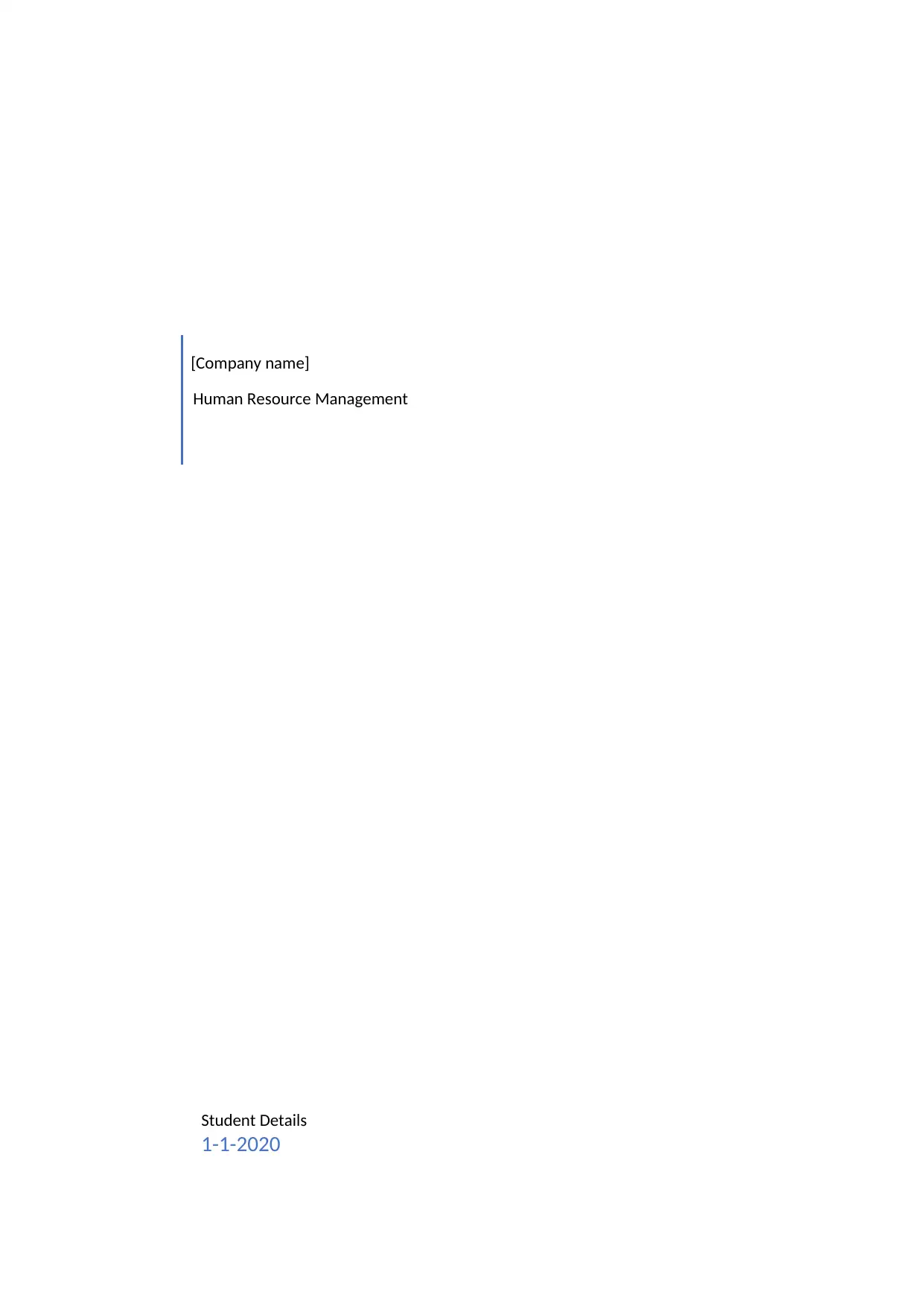
[Company name]
Human Resource Management
Student Details
1-1-2020
Human Resource Management
Student Details
1-1-2020
Paraphrase This Document
Need a fresh take? Get an instant paraphrase of this document with our AI Paraphraser
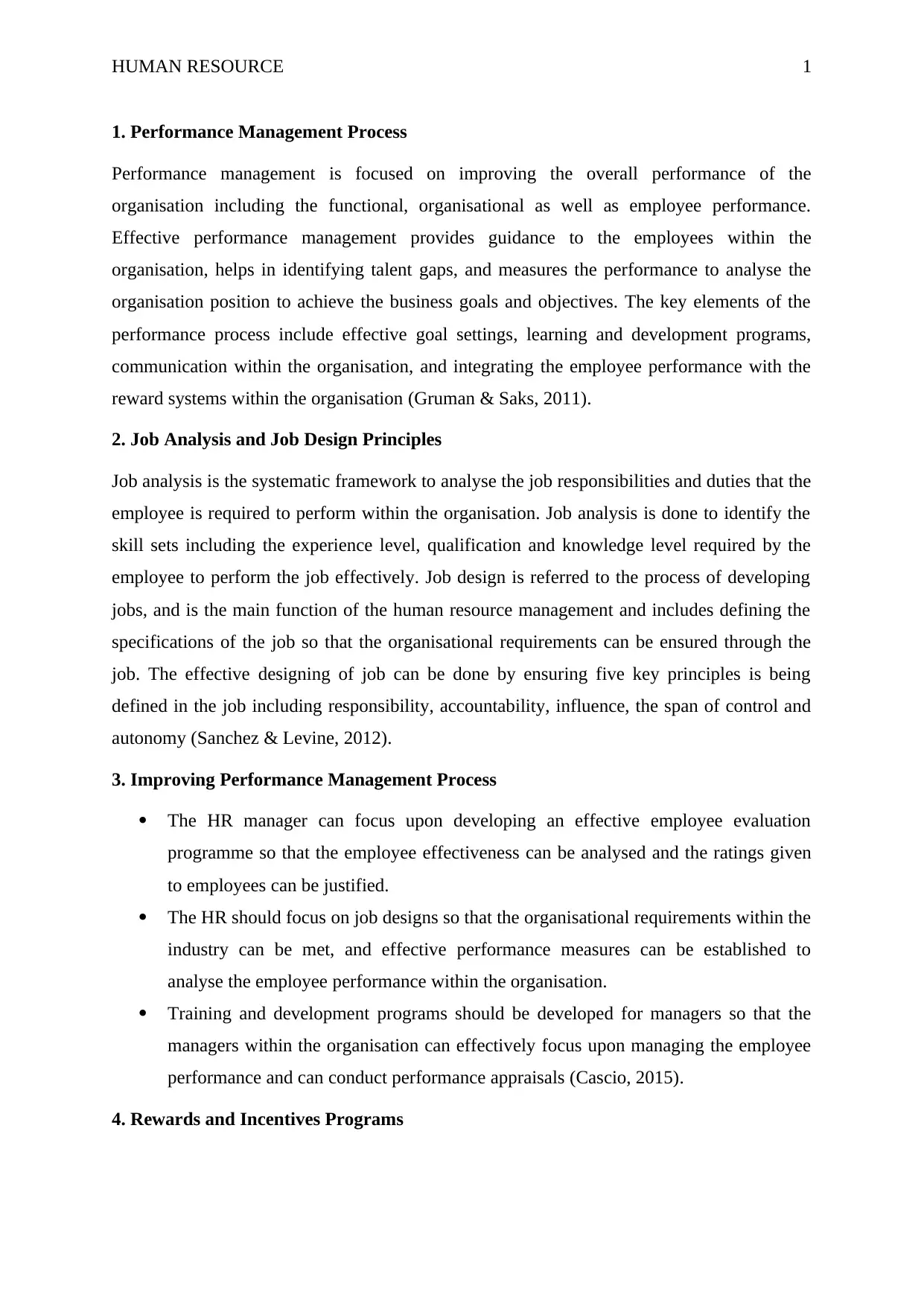
HUMAN RESOURCE 1
1. Performance Management Process
Performance management is focused on improving the overall performance of the
organisation including the functional, organisational as well as employee performance.
Effective performance management provides guidance to the employees within the
organisation, helps in identifying talent gaps, and measures the performance to analyse the
organisation position to achieve the business goals and objectives. The key elements of the
performance process include effective goal settings, learning and development programs,
communication within the organisation, and integrating the employee performance with the
reward systems within the organisation (Gruman & Saks, 2011).
2. Job Analysis and Job Design Principles
Job analysis is the systematic framework to analyse the job responsibilities and duties that the
employee is required to perform within the organisation. Job analysis is done to identify the
skill sets including the experience level, qualification and knowledge level required by the
employee to perform the job effectively. Job design is referred to the process of developing
jobs, and is the main function of the human resource management and includes defining the
specifications of the job so that the organisational requirements can be ensured through the
job. The effective designing of job can be done by ensuring five key principles is being
defined in the job including responsibility, accountability, influence, the span of control and
autonomy (Sanchez & Levine, 2012).
3. Improving Performance Management Process
The HR manager can focus upon developing an effective employee evaluation
programme so that the employee effectiveness can be analysed and the ratings given
to employees can be justified.
The HR should focus on job designs so that the organisational requirements within the
industry can be met, and effective performance measures can be established to
analyse the employee performance within the organisation.
Training and development programs should be developed for managers so that the
managers within the organisation can effectively focus upon managing the employee
performance and can conduct performance appraisals (Cascio, 2015).
4. Rewards and Incentives Programs
1. Performance Management Process
Performance management is focused on improving the overall performance of the
organisation including the functional, organisational as well as employee performance.
Effective performance management provides guidance to the employees within the
organisation, helps in identifying talent gaps, and measures the performance to analyse the
organisation position to achieve the business goals and objectives. The key elements of the
performance process include effective goal settings, learning and development programs,
communication within the organisation, and integrating the employee performance with the
reward systems within the organisation (Gruman & Saks, 2011).
2. Job Analysis and Job Design Principles
Job analysis is the systematic framework to analyse the job responsibilities and duties that the
employee is required to perform within the organisation. Job analysis is done to identify the
skill sets including the experience level, qualification and knowledge level required by the
employee to perform the job effectively. Job design is referred to the process of developing
jobs, and is the main function of the human resource management and includes defining the
specifications of the job so that the organisational requirements can be ensured through the
job. The effective designing of job can be done by ensuring five key principles is being
defined in the job including responsibility, accountability, influence, the span of control and
autonomy (Sanchez & Levine, 2012).
3. Improving Performance Management Process
The HR manager can focus upon developing an effective employee evaluation
programme so that the employee effectiveness can be analysed and the ratings given
to employees can be justified.
The HR should focus on job designs so that the organisational requirements within the
industry can be met, and effective performance measures can be established to
analyse the employee performance within the organisation.
Training and development programs should be developed for managers so that the
managers within the organisation can effectively focus upon managing the employee
performance and can conduct performance appraisals (Cascio, 2015).
4. Rewards and Incentives Programs
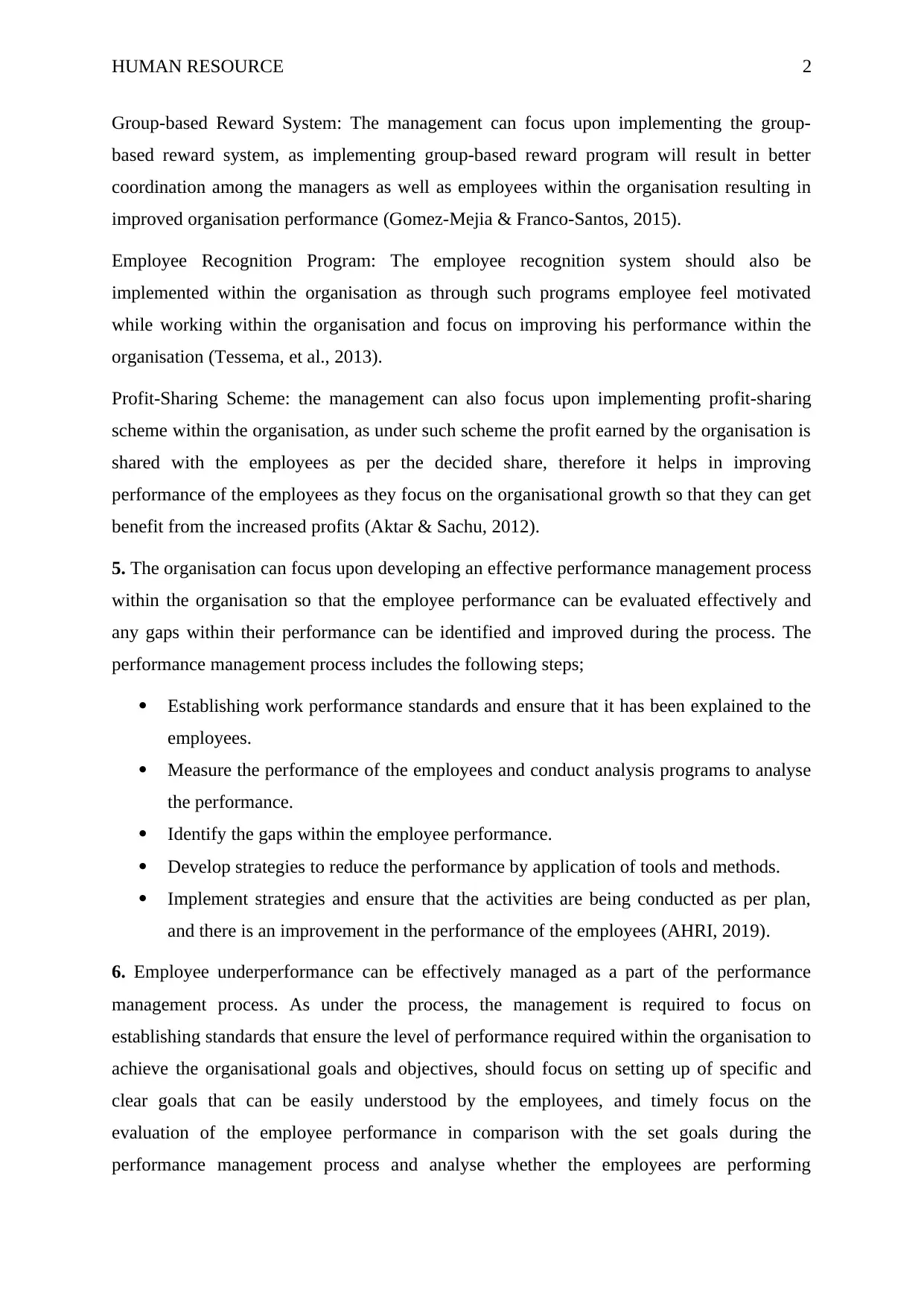
HUMAN RESOURCE 2
Group-based Reward System: The management can focus upon implementing the group-
based reward system, as implementing group-based reward program will result in better
coordination among the managers as well as employees within the organisation resulting in
improved organisation performance (Gomez-Mejia & Franco-Santos, 2015).
Employee Recognition Program: The employee recognition system should also be
implemented within the organisation as through such programs employee feel motivated
while working within the organisation and focus on improving his performance within the
organisation (Tessema, et al., 2013).
Profit-Sharing Scheme: the management can also focus upon implementing profit-sharing
scheme within the organisation, as under such scheme the profit earned by the organisation is
shared with the employees as per the decided share, therefore it helps in improving
performance of the employees as they focus on the organisational growth so that they can get
benefit from the increased profits (Aktar & Sachu, 2012).
5. The organisation can focus upon developing an effective performance management process
within the organisation so that the employee performance can be evaluated effectively and
any gaps within their performance can be identified and improved during the process. The
performance management process includes the following steps;
Establishing work performance standards and ensure that it has been explained to the
employees.
Measure the performance of the employees and conduct analysis programs to analyse
the performance.
Identify the gaps within the employee performance.
Develop strategies to reduce the performance by application of tools and methods.
Implement strategies and ensure that the activities are being conducted as per plan,
and there is an improvement in the performance of the employees (AHRI, 2019).
6. Employee underperformance can be effectively managed as a part of the performance
management process. As under the process, the management is required to focus on
establishing standards that ensure the level of performance required within the organisation to
achieve the organisational goals and objectives, should focus on setting up of specific and
clear goals that can be easily understood by the employees, and timely focus on the
evaluation of the employee performance in comparison with the set goals during the
performance management process and analyse whether the employees are performing
Group-based Reward System: The management can focus upon implementing the group-
based reward system, as implementing group-based reward program will result in better
coordination among the managers as well as employees within the organisation resulting in
improved organisation performance (Gomez-Mejia & Franco-Santos, 2015).
Employee Recognition Program: The employee recognition system should also be
implemented within the organisation as through such programs employee feel motivated
while working within the organisation and focus on improving his performance within the
organisation (Tessema, et al., 2013).
Profit-Sharing Scheme: the management can also focus upon implementing profit-sharing
scheme within the organisation, as under such scheme the profit earned by the organisation is
shared with the employees as per the decided share, therefore it helps in improving
performance of the employees as they focus on the organisational growth so that they can get
benefit from the increased profits (Aktar & Sachu, 2012).
5. The organisation can focus upon developing an effective performance management process
within the organisation so that the employee performance can be evaluated effectively and
any gaps within their performance can be identified and improved during the process. The
performance management process includes the following steps;
Establishing work performance standards and ensure that it has been explained to the
employees.
Measure the performance of the employees and conduct analysis programs to analyse
the performance.
Identify the gaps within the employee performance.
Develop strategies to reduce the performance by application of tools and methods.
Implement strategies and ensure that the activities are being conducted as per plan,
and there is an improvement in the performance of the employees (AHRI, 2019).
6. Employee underperformance can be effectively managed as a part of the performance
management process. As under the process, the management is required to focus on
establishing standards that ensure the level of performance required within the organisation to
achieve the organisational goals and objectives, should focus on setting up of specific and
clear goals that can be easily understood by the employees, and timely focus on the
evaluation of the employee performance in comparison with the set goals during the
performance management process and analyse whether the employees are performing
⊘ This is a preview!⊘
Do you want full access?
Subscribe today to unlock all pages.

Trusted by 1+ million students worldwide
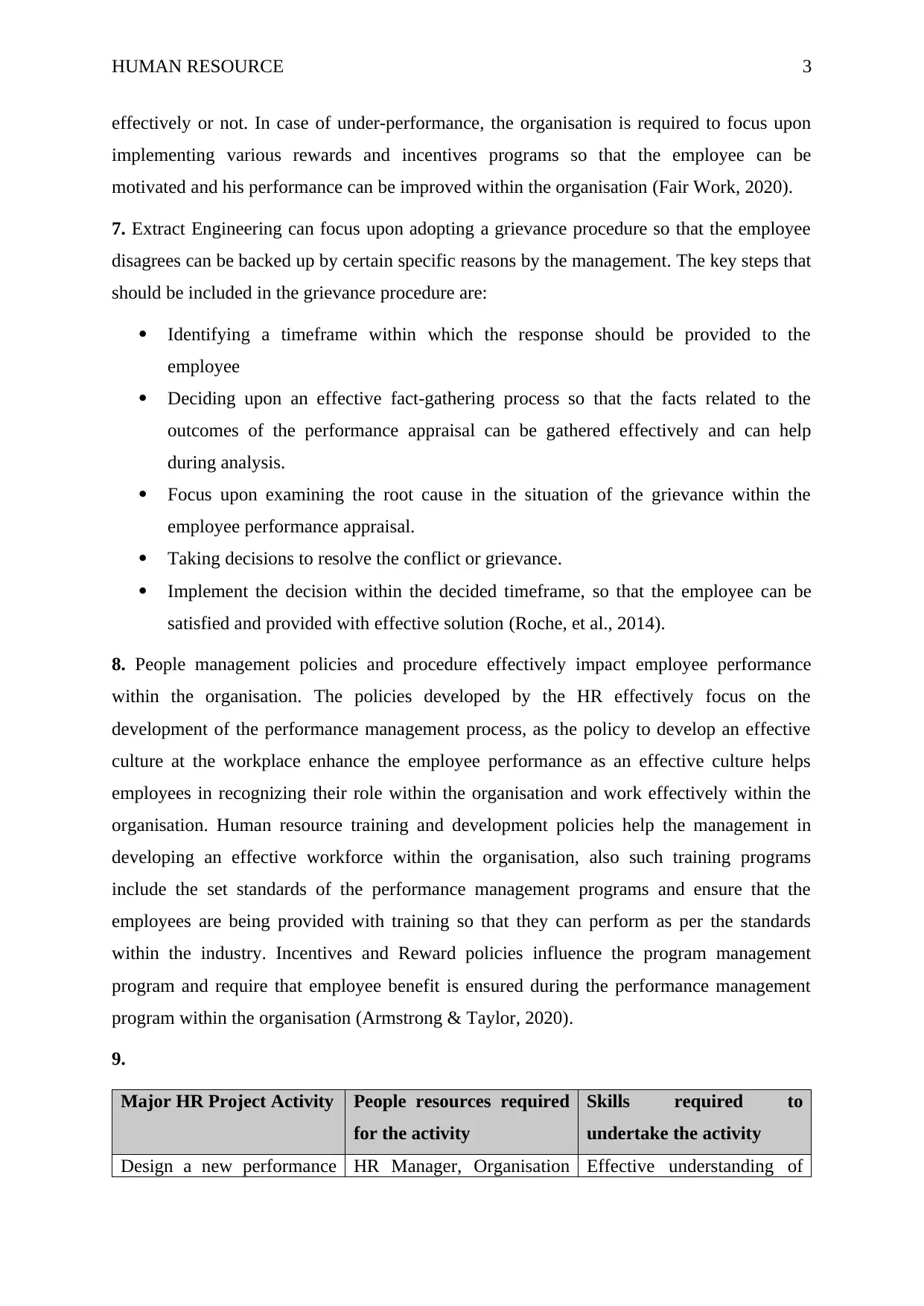
HUMAN RESOURCE 3
effectively or not. In case of under-performance, the organisation is required to focus upon
implementing various rewards and incentives programs so that the employee can be
motivated and his performance can be improved within the organisation (Fair Work, 2020).
7. Extract Engineering can focus upon adopting a grievance procedure so that the employee
disagrees can be backed up by certain specific reasons by the management. The key steps that
should be included in the grievance procedure are:
Identifying a timeframe within which the response should be provided to the
employee
Deciding upon an effective fact-gathering process so that the facts related to the
outcomes of the performance appraisal can be gathered effectively and can help
during analysis.
Focus upon examining the root cause in the situation of the grievance within the
employee performance appraisal.
Taking decisions to resolve the conflict or grievance.
Implement the decision within the decided timeframe, so that the employee can be
satisfied and provided with effective solution (Roche, et al., 2014).
8. People management policies and procedure effectively impact employee performance
within the organisation. The policies developed by the HR effectively focus on the
development of the performance management process, as the policy to develop an effective
culture at the workplace enhance the employee performance as an effective culture helps
employees in recognizing their role within the organisation and work effectively within the
organisation. Human resource training and development policies help the management in
developing an effective workforce within the organisation, also such training programs
include the set standards of the performance management programs and ensure that the
employees are being provided with training so that they can perform as per the standards
within the industry. Incentives and Reward policies influence the program management
program and require that employee benefit is ensured during the performance management
program within the organisation (Armstrong & Taylor, 2020).
9.
Major HR Project Activity People resources required
for the activity
Skills required to
undertake the activity
Design a new performance HR Manager, Organisation Effective understanding of
effectively or not. In case of under-performance, the organisation is required to focus upon
implementing various rewards and incentives programs so that the employee can be
motivated and his performance can be improved within the organisation (Fair Work, 2020).
7. Extract Engineering can focus upon adopting a grievance procedure so that the employee
disagrees can be backed up by certain specific reasons by the management. The key steps that
should be included in the grievance procedure are:
Identifying a timeframe within which the response should be provided to the
employee
Deciding upon an effective fact-gathering process so that the facts related to the
outcomes of the performance appraisal can be gathered effectively and can help
during analysis.
Focus upon examining the root cause in the situation of the grievance within the
employee performance appraisal.
Taking decisions to resolve the conflict or grievance.
Implement the decision within the decided timeframe, so that the employee can be
satisfied and provided with effective solution (Roche, et al., 2014).
8. People management policies and procedure effectively impact employee performance
within the organisation. The policies developed by the HR effectively focus on the
development of the performance management process, as the policy to develop an effective
culture at the workplace enhance the employee performance as an effective culture helps
employees in recognizing their role within the organisation and work effectively within the
organisation. Human resource training and development policies help the management in
developing an effective workforce within the organisation, also such training programs
include the set standards of the performance management programs and ensure that the
employees are being provided with training so that they can perform as per the standards
within the industry. Incentives and Reward policies influence the program management
program and require that employee benefit is ensured during the performance management
program within the organisation (Armstrong & Taylor, 2020).
9.
Major HR Project Activity People resources required
for the activity
Skills required to
undertake the activity
Design a new performance HR Manager, Organisation Effective understanding of
Paraphrase This Document
Need a fresh take? Get an instant paraphrase of this document with our AI Paraphraser
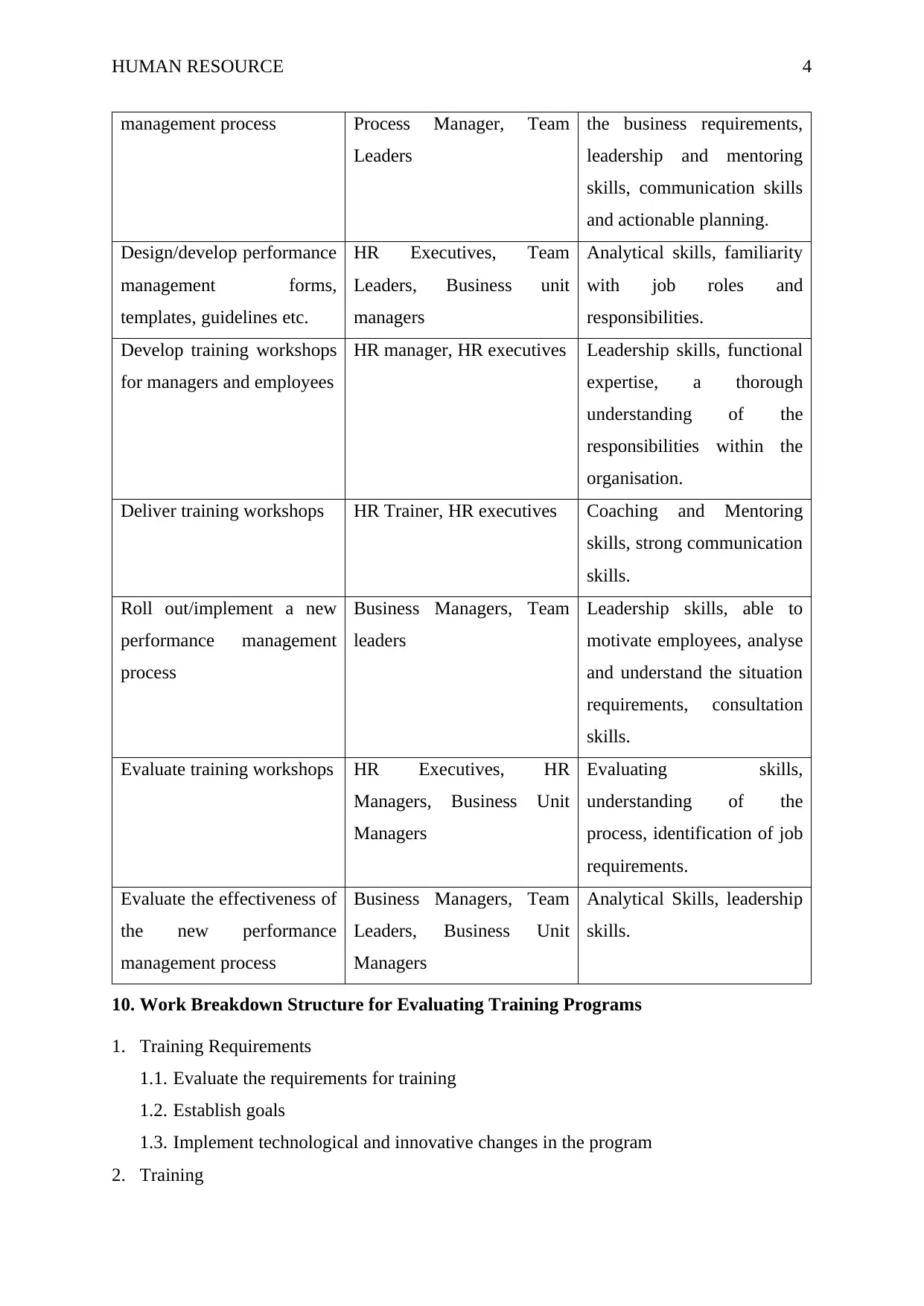
HUMAN RESOURCE 4
management process Process Manager, Team
Leaders
the business requirements,
leadership and mentoring
skills, communication skills
and actionable planning.
Design/develop performance
management forms,
templates, guidelines etc.
HR Executives, Team
Leaders, Business unit
managers
Analytical skills, familiarity
with job roles and
responsibilities.
Develop training workshops
for managers and employees
HR manager, HR executives Leadership skills, functional
expertise, a thorough
understanding of the
responsibilities within the
organisation.
Deliver training workshops HR Trainer, HR executives Coaching and Mentoring
skills, strong communication
skills.
Roll out/implement a new
performance management
process
Business Managers, Team
leaders
Leadership skills, able to
motivate employees, analyse
and understand the situation
requirements, consultation
skills.
Evaluate training workshops HR Executives, HR
Managers, Business Unit
Managers
Evaluating skills,
understanding of the
process, identification of job
requirements.
Evaluate the effectiveness of
the new performance
management process
Business Managers, Team
Leaders, Business Unit
Managers
Analytical Skills, leadership
skills.
10. Work Breakdown Structure for Evaluating Training Programs
1. Training Requirements
1.1. Evaluate the requirements for training
1.2. Establish goals
1.3. Implement technological and innovative changes in the program
2. Training
management process Process Manager, Team
Leaders
the business requirements,
leadership and mentoring
skills, communication skills
and actionable planning.
Design/develop performance
management forms,
templates, guidelines etc.
HR Executives, Team
Leaders, Business unit
managers
Analytical skills, familiarity
with job roles and
responsibilities.
Develop training workshops
for managers and employees
HR manager, HR executives Leadership skills, functional
expertise, a thorough
understanding of the
responsibilities within the
organisation.
Deliver training workshops HR Trainer, HR executives Coaching and Mentoring
skills, strong communication
skills.
Roll out/implement a new
performance management
process
Business Managers, Team
leaders
Leadership skills, able to
motivate employees, analyse
and understand the situation
requirements, consultation
skills.
Evaluate training workshops HR Executives, HR
Managers, Business Unit
Managers
Evaluating skills,
understanding of the
process, identification of job
requirements.
Evaluate the effectiveness of
the new performance
management process
Business Managers, Team
Leaders, Business Unit
Managers
Analytical Skills, leadership
skills.
10. Work Breakdown Structure for Evaluating Training Programs
1. Training Requirements
1.1. Evaluate the requirements for training
1.2. Establish goals
1.3. Implement technological and innovative changes in the program
2. Training
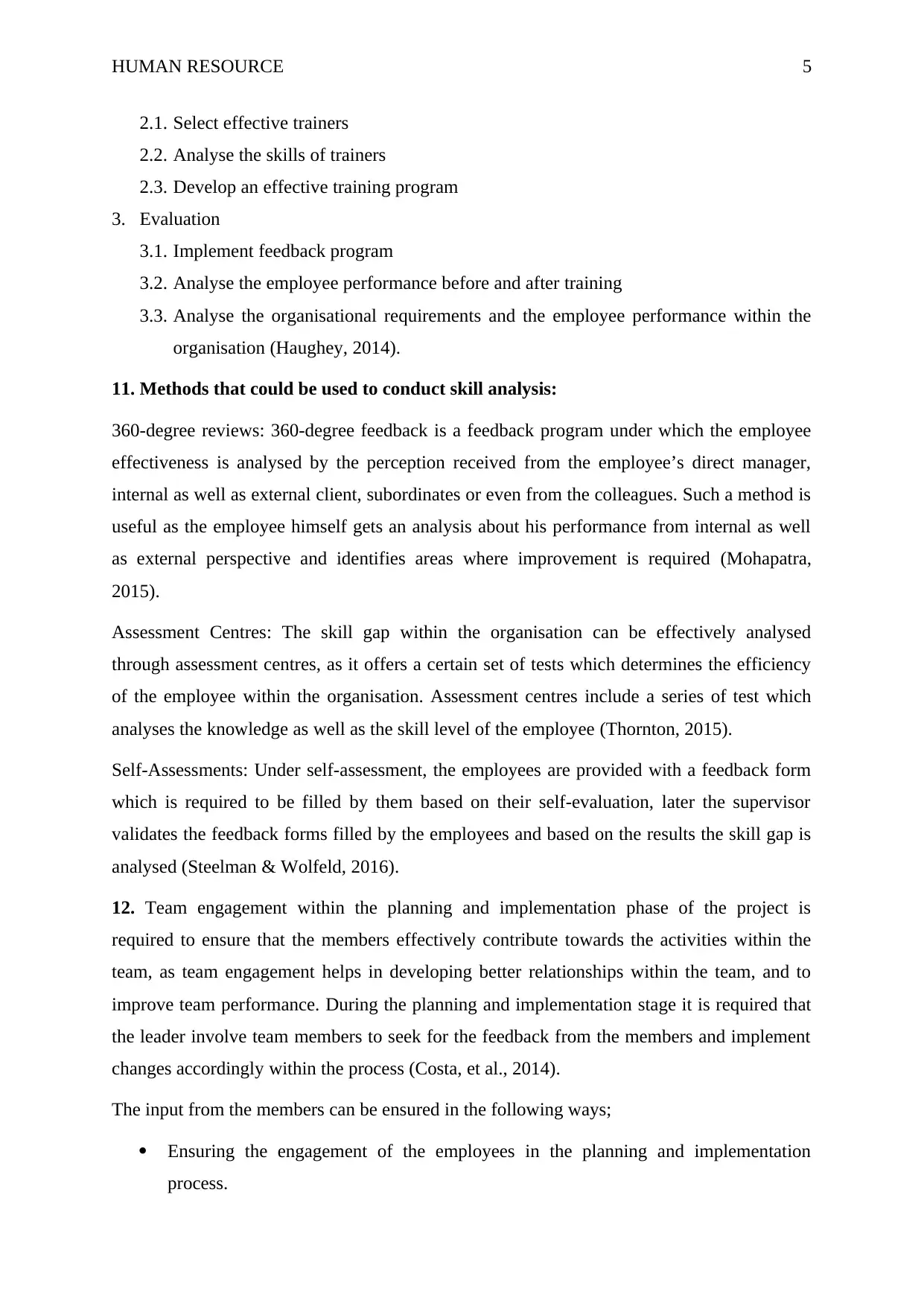
HUMAN RESOURCE 5
2.1. Select effective trainers
2.2. Analyse the skills of trainers
2.3. Develop an effective training program
3. Evaluation
3.1. Implement feedback program
3.2. Analyse the employee performance before and after training
3.3. Analyse the organisational requirements and the employee performance within the
organisation (Haughey, 2014).
11. Methods that could be used to conduct skill analysis:
360-degree reviews: 360-degree feedback is a feedback program under which the employee
effectiveness is analysed by the perception received from the employee’s direct manager,
internal as well as external client, subordinates or even from the colleagues. Such a method is
useful as the employee himself gets an analysis about his performance from internal as well
as external perspective and identifies areas where improvement is required (Mohapatra,
2015).
Assessment Centres: The skill gap within the organisation can be effectively analysed
through assessment centres, as it offers a certain set of tests which determines the efficiency
of the employee within the organisation. Assessment centres include a series of test which
analyses the knowledge as well as the skill level of the employee (Thornton, 2015).
Self-Assessments: Under self-assessment, the employees are provided with a feedback form
which is required to be filled by them based on their self-evaluation, later the supervisor
validates the feedback forms filled by the employees and based on the results the skill gap is
analysed (Steelman & Wolfeld, 2016).
12. Team engagement within the planning and implementation phase of the project is
required to ensure that the members effectively contribute towards the activities within the
team, as team engagement helps in developing better relationships within the team, and to
improve team performance. During the planning and implementation stage it is required that
the leader involve team members to seek for the feedback from the members and implement
changes accordingly within the process (Costa, et al., 2014).
The input from the members can be ensured in the following ways;
Ensuring the engagement of the employees in the planning and implementation
process.
2.1. Select effective trainers
2.2. Analyse the skills of trainers
2.3. Develop an effective training program
3. Evaluation
3.1. Implement feedback program
3.2. Analyse the employee performance before and after training
3.3. Analyse the organisational requirements and the employee performance within the
organisation (Haughey, 2014).
11. Methods that could be used to conduct skill analysis:
360-degree reviews: 360-degree feedback is a feedback program under which the employee
effectiveness is analysed by the perception received from the employee’s direct manager,
internal as well as external client, subordinates or even from the colleagues. Such a method is
useful as the employee himself gets an analysis about his performance from internal as well
as external perspective and identifies areas where improvement is required (Mohapatra,
2015).
Assessment Centres: The skill gap within the organisation can be effectively analysed
through assessment centres, as it offers a certain set of tests which determines the efficiency
of the employee within the organisation. Assessment centres include a series of test which
analyses the knowledge as well as the skill level of the employee (Thornton, 2015).
Self-Assessments: Under self-assessment, the employees are provided with a feedback form
which is required to be filled by them based on their self-evaluation, later the supervisor
validates the feedback forms filled by the employees and based on the results the skill gap is
analysed (Steelman & Wolfeld, 2016).
12. Team engagement within the planning and implementation phase of the project is
required to ensure that the members effectively contribute towards the activities within the
team, as team engagement helps in developing better relationships within the team, and to
improve team performance. During the planning and implementation stage it is required that
the leader involve team members to seek for the feedback from the members and implement
changes accordingly within the process (Costa, et al., 2014).
The input from the members can be ensured in the following ways;
Ensuring the engagement of the employees in the planning and implementation
process.
⊘ This is a preview!⊘
Do you want full access?
Subscribe today to unlock all pages.

Trusted by 1+ million students worldwide
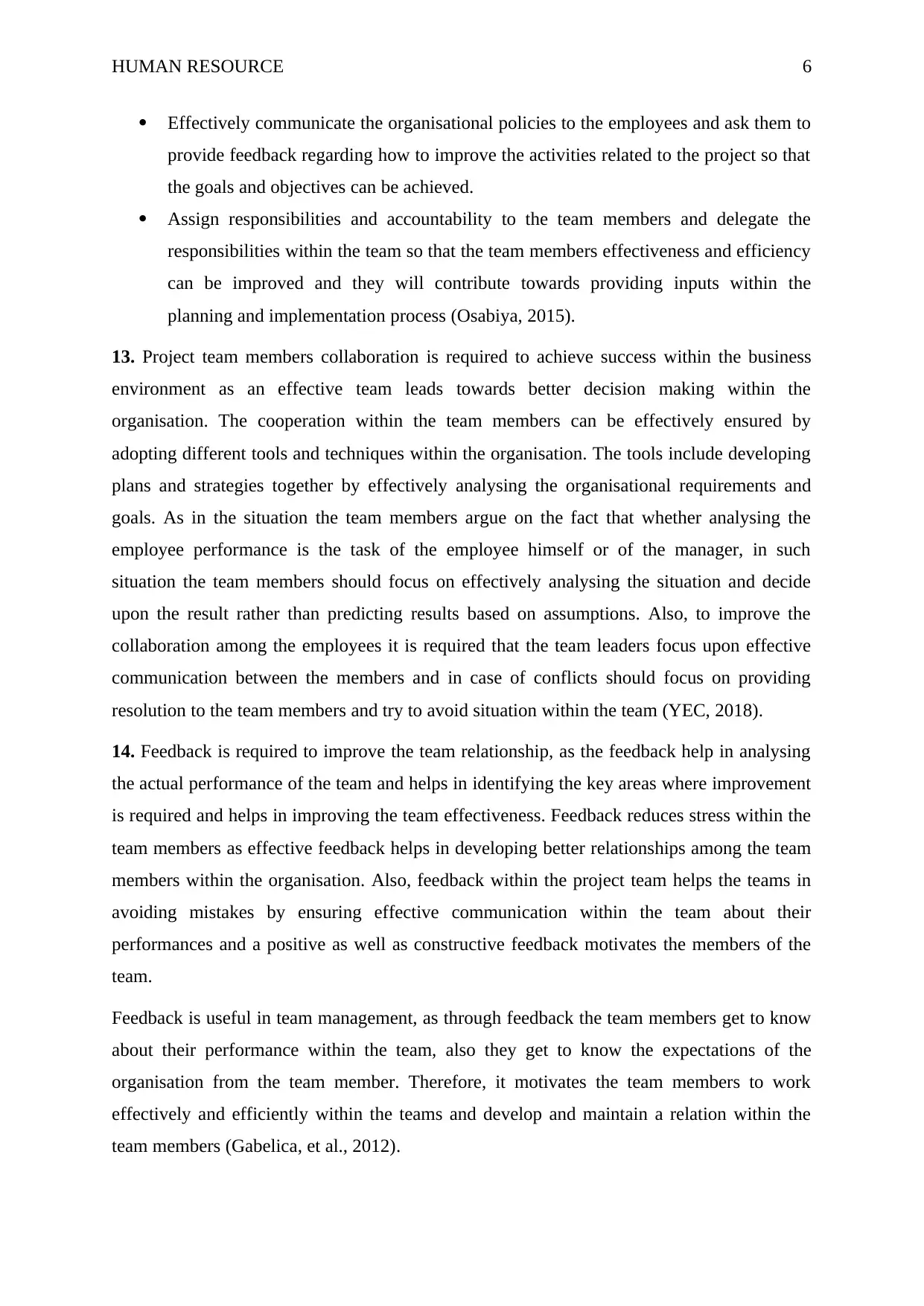
HUMAN RESOURCE 6
Effectively communicate the organisational policies to the employees and ask them to
provide feedback regarding how to improve the activities related to the project so that
the goals and objectives can be achieved.
Assign responsibilities and accountability to the team members and delegate the
responsibilities within the team so that the team members effectiveness and efficiency
can be improved and they will contribute towards providing inputs within the
planning and implementation process (Osabiya, 2015).
13. Project team members collaboration is required to achieve success within the business
environment as an effective team leads towards better decision making within the
organisation. The cooperation within the team members can be effectively ensured by
adopting different tools and techniques within the organisation. The tools include developing
plans and strategies together by effectively analysing the organisational requirements and
goals. As in the situation the team members argue on the fact that whether analysing the
employee performance is the task of the employee himself or of the manager, in such
situation the team members should focus on effectively analysing the situation and decide
upon the result rather than predicting results based on assumptions. Also, to improve the
collaboration among the employees it is required that the team leaders focus upon effective
communication between the members and in case of conflicts should focus on providing
resolution to the team members and try to avoid situation within the team (YEC, 2018).
14. Feedback is required to improve the team relationship, as the feedback help in analysing
the actual performance of the team and helps in identifying the key areas where improvement
is required and helps in improving the team effectiveness. Feedback reduces stress within the
team members as effective feedback helps in developing better relationships among the team
members within the organisation. Also, feedback within the project team helps the teams in
avoiding mistakes by ensuring effective communication within the team about their
performances and a positive as well as constructive feedback motivates the members of the
team.
Feedback is useful in team management, as through feedback the team members get to know
about their performance within the team, also they get to know the expectations of the
organisation from the team member. Therefore, it motivates the team members to work
effectively and efficiently within the teams and develop and maintain a relation within the
team members (Gabelica, et al., 2012).
Effectively communicate the organisational policies to the employees and ask them to
provide feedback regarding how to improve the activities related to the project so that
the goals and objectives can be achieved.
Assign responsibilities and accountability to the team members and delegate the
responsibilities within the team so that the team members effectiveness and efficiency
can be improved and they will contribute towards providing inputs within the
planning and implementation process (Osabiya, 2015).
13. Project team members collaboration is required to achieve success within the business
environment as an effective team leads towards better decision making within the
organisation. The cooperation within the team members can be effectively ensured by
adopting different tools and techniques within the organisation. The tools include developing
plans and strategies together by effectively analysing the organisational requirements and
goals. As in the situation the team members argue on the fact that whether analysing the
employee performance is the task of the employee himself or of the manager, in such
situation the team members should focus on effectively analysing the situation and decide
upon the result rather than predicting results based on assumptions. Also, to improve the
collaboration among the employees it is required that the team leaders focus upon effective
communication between the members and in case of conflicts should focus on providing
resolution to the team members and try to avoid situation within the team (YEC, 2018).
14. Feedback is required to improve the team relationship, as the feedback help in analysing
the actual performance of the team and helps in identifying the key areas where improvement
is required and helps in improving the team effectiveness. Feedback reduces stress within the
team members as effective feedback helps in developing better relationships among the team
members within the organisation. Also, feedback within the project team helps the teams in
avoiding mistakes by ensuring effective communication within the team about their
performances and a positive as well as constructive feedback motivates the members of the
team.
Feedback is useful in team management, as through feedback the team members get to know
about their performance within the team, also they get to know the expectations of the
organisation from the team member. Therefore, it motivates the team members to work
effectively and efficiently within the teams and develop and maintain a relation within the
team members (Gabelica, et al., 2012).
Paraphrase This Document
Need a fresh take? Get an instant paraphrase of this document with our AI Paraphraser
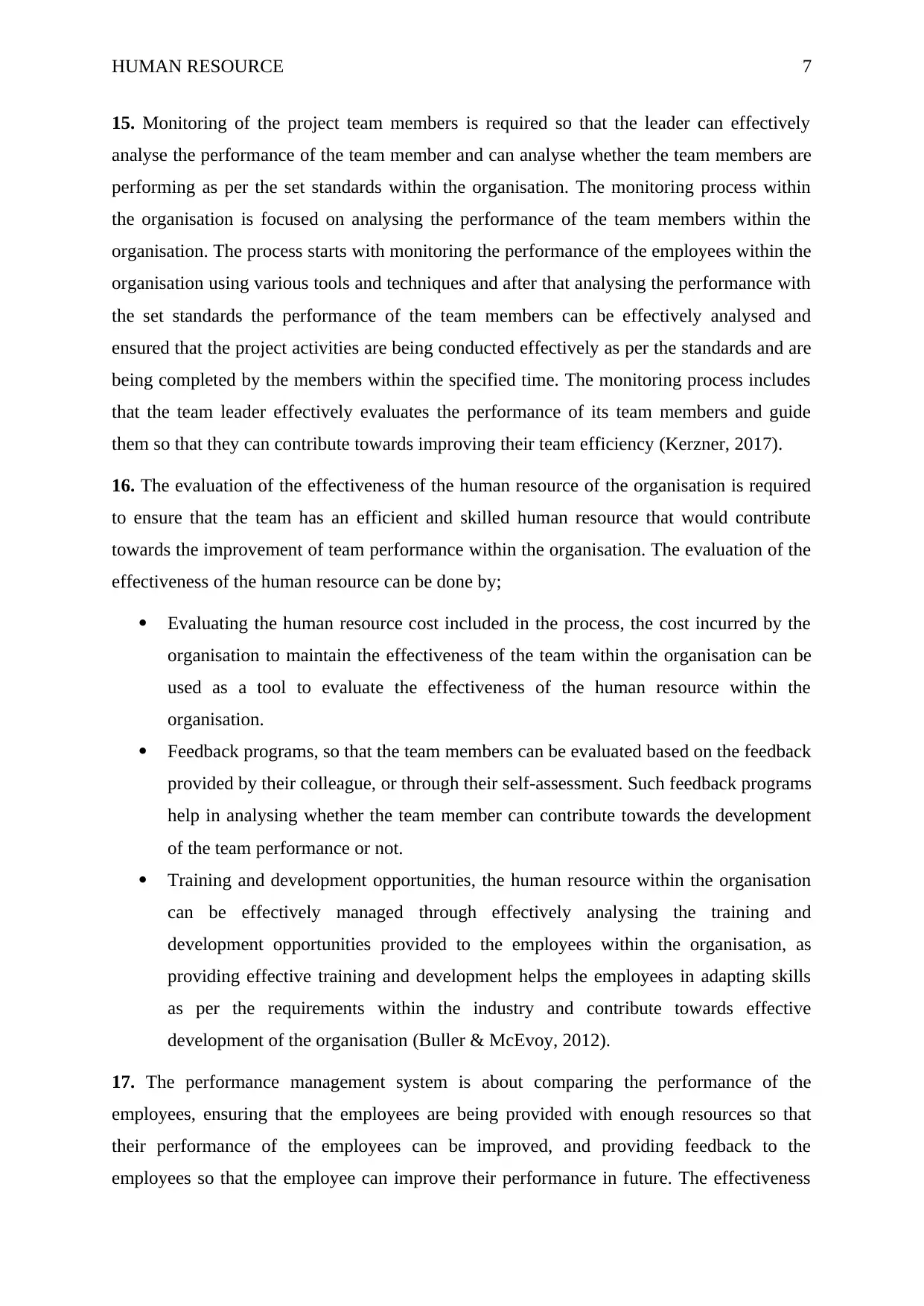
HUMAN RESOURCE 7
15. Monitoring of the project team members is required so that the leader can effectively
analyse the performance of the team member and can analyse whether the team members are
performing as per the set standards within the organisation. The monitoring process within
the organisation is focused on analysing the performance of the team members within the
organisation. The process starts with monitoring the performance of the employees within the
organisation using various tools and techniques and after that analysing the performance with
the set standards the performance of the team members can be effectively analysed and
ensured that the project activities are being conducted effectively as per the standards and are
being completed by the members within the specified time. The monitoring process includes
that the team leader effectively evaluates the performance of its team members and guide
them so that they can contribute towards improving their team efficiency (Kerzner, 2017).
16. The evaluation of the effectiveness of the human resource of the organisation is required
to ensure that the team has an efficient and skilled human resource that would contribute
towards the improvement of team performance within the organisation. The evaluation of the
effectiveness of the human resource can be done by;
Evaluating the human resource cost included in the process, the cost incurred by the
organisation to maintain the effectiveness of the team within the organisation can be
used as a tool to evaluate the effectiveness of the human resource within the
organisation.
Feedback programs, so that the team members can be evaluated based on the feedback
provided by their colleague, or through their self-assessment. Such feedback programs
help in analysing whether the team member can contribute towards the development
of the team performance or not.
Training and development opportunities, the human resource within the organisation
can be effectively managed through effectively analysing the training and
development opportunities provided to the employees within the organisation, as
providing effective training and development helps the employees in adapting skills
as per the requirements within the industry and contribute towards effective
development of the organisation (Buller & McEvoy, 2012).
17. The performance management system is about comparing the performance of the
employees, ensuring that the employees are being provided with enough resources so that
their performance of the employees can be improved, and providing feedback to the
employees so that the employee can improve their performance in future. The effectiveness
15. Monitoring of the project team members is required so that the leader can effectively
analyse the performance of the team member and can analyse whether the team members are
performing as per the set standards within the organisation. The monitoring process within
the organisation is focused on analysing the performance of the team members within the
organisation. The process starts with monitoring the performance of the employees within the
organisation using various tools and techniques and after that analysing the performance with
the set standards the performance of the team members can be effectively analysed and
ensured that the project activities are being conducted effectively as per the standards and are
being completed by the members within the specified time. The monitoring process includes
that the team leader effectively evaluates the performance of its team members and guide
them so that they can contribute towards improving their team efficiency (Kerzner, 2017).
16. The evaluation of the effectiveness of the human resource of the organisation is required
to ensure that the team has an efficient and skilled human resource that would contribute
towards the improvement of team performance within the organisation. The evaluation of the
effectiveness of the human resource can be done by;
Evaluating the human resource cost included in the process, the cost incurred by the
organisation to maintain the effectiveness of the team within the organisation can be
used as a tool to evaluate the effectiveness of the human resource within the
organisation.
Feedback programs, so that the team members can be evaluated based on the feedback
provided by their colleague, or through their self-assessment. Such feedback programs
help in analysing whether the team member can contribute towards the development
of the team performance or not.
Training and development opportunities, the human resource within the organisation
can be effectively managed through effectively analysing the training and
development opportunities provided to the employees within the organisation, as
providing effective training and development helps the employees in adapting skills
as per the requirements within the industry and contribute towards effective
development of the organisation (Buller & McEvoy, 2012).
17. The performance management system is about comparing the performance of the
employees, ensuring that the employees are being provided with enough resources so that
their performance of the employees can be improved, and providing feedback to the
employees so that the employee can improve their performance in future. The effectiveness
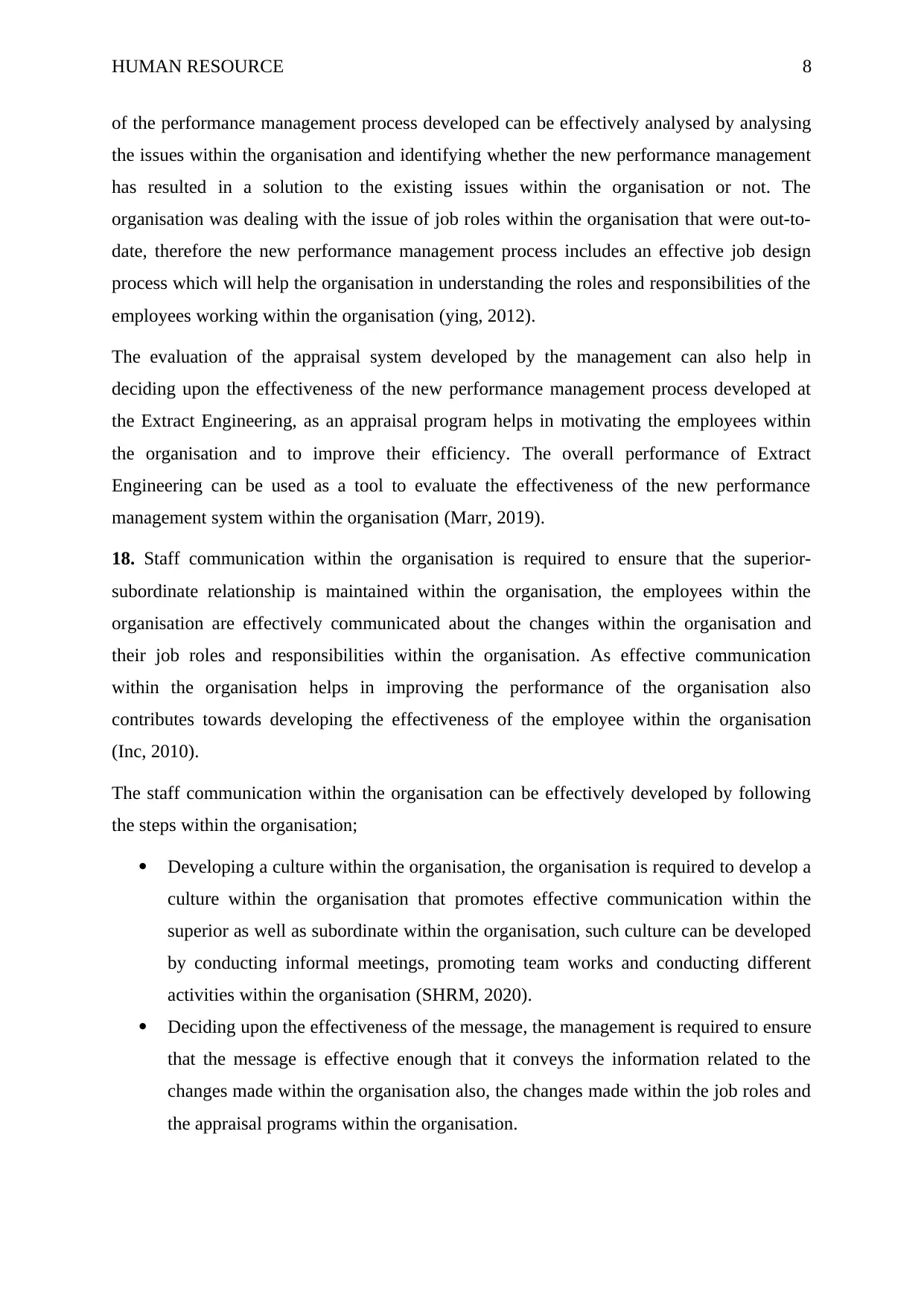
HUMAN RESOURCE 8
of the performance management process developed can be effectively analysed by analysing
the issues within the organisation and identifying whether the new performance management
has resulted in a solution to the existing issues within the organisation or not. The
organisation was dealing with the issue of job roles within the organisation that were out-to-
date, therefore the new performance management process includes an effective job design
process which will help the organisation in understanding the roles and responsibilities of the
employees working within the organisation (ying, 2012).
The evaluation of the appraisal system developed by the management can also help in
deciding upon the effectiveness of the new performance management process developed at
the Extract Engineering, as an appraisal program helps in motivating the employees within
the organisation and to improve their efficiency. The overall performance of Extract
Engineering can be used as a tool to evaluate the effectiveness of the new performance
management system within the organisation (Marr, 2019).
18. Staff communication within the organisation is required to ensure that the superior-
subordinate relationship is maintained within the organisation, the employees within the
organisation are effectively communicated about the changes within the organisation and
their job roles and responsibilities within the organisation. As effective communication
within the organisation helps in improving the performance of the organisation also
contributes towards developing the effectiveness of the employee within the organisation
(Inc, 2010).
The staff communication within the organisation can be effectively developed by following
the steps within the organisation;
Developing a culture within the organisation, the organisation is required to develop a
culture within the organisation that promotes effective communication within the
superior as well as subordinate within the organisation, such culture can be developed
by conducting informal meetings, promoting team works and conducting different
activities within the organisation (SHRM, 2020).
Deciding upon the effectiveness of the message, the management is required to ensure
that the message is effective enough that it conveys the information related to the
changes made within the organisation also, the changes made within the job roles and
the appraisal programs within the organisation.
of the performance management process developed can be effectively analysed by analysing
the issues within the organisation and identifying whether the new performance management
has resulted in a solution to the existing issues within the organisation or not. The
organisation was dealing with the issue of job roles within the organisation that were out-to-
date, therefore the new performance management process includes an effective job design
process which will help the organisation in understanding the roles and responsibilities of the
employees working within the organisation (ying, 2012).
The evaluation of the appraisal system developed by the management can also help in
deciding upon the effectiveness of the new performance management process developed at
the Extract Engineering, as an appraisal program helps in motivating the employees within
the organisation and to improve their efficiency. The overall performance of Extract
Engineering can be used as a tool to evaluate the effectiveness of the new performance
management system within the organisation (Marr, 2019).
18. Staff communication within the organisation is required to ensure that the superior-
subordinate relationship is maintained within the organisation, the employees within the
organisation are effectively communicated about the changes within the organisation and
their job roles and responsibilities within the organisation. As effective communication
within the organisation helps in improving the performance of the organisation also
contributes towards developing the effectiveness of the employee within the organisation
(Inc, 2010).
The staff communication within the organisation can be effectively developed by following
the steps within the organisation;
Developing a culture within the organisation, the organisation is required to develop a
culture within the organisation that promotes effective communication within the
superior as well as subordinate within the organisation, such culture can be developed
by conducting informal meetings, promoting team works and conducting different
activities within the organisation (SHRM, 2020).
Deciding upon the effectiveness of the message, the management is required to ensure
that the message is effective enough that it conveys the information related to the
changes made within the organisation also, the changes made within the job roles and
the appraisal programs within the organisation.
⊘ This is a preview!⊘
Do you want full access?
Subscribe today to unlock all pages.

Trusted by 1+ million students worldwide
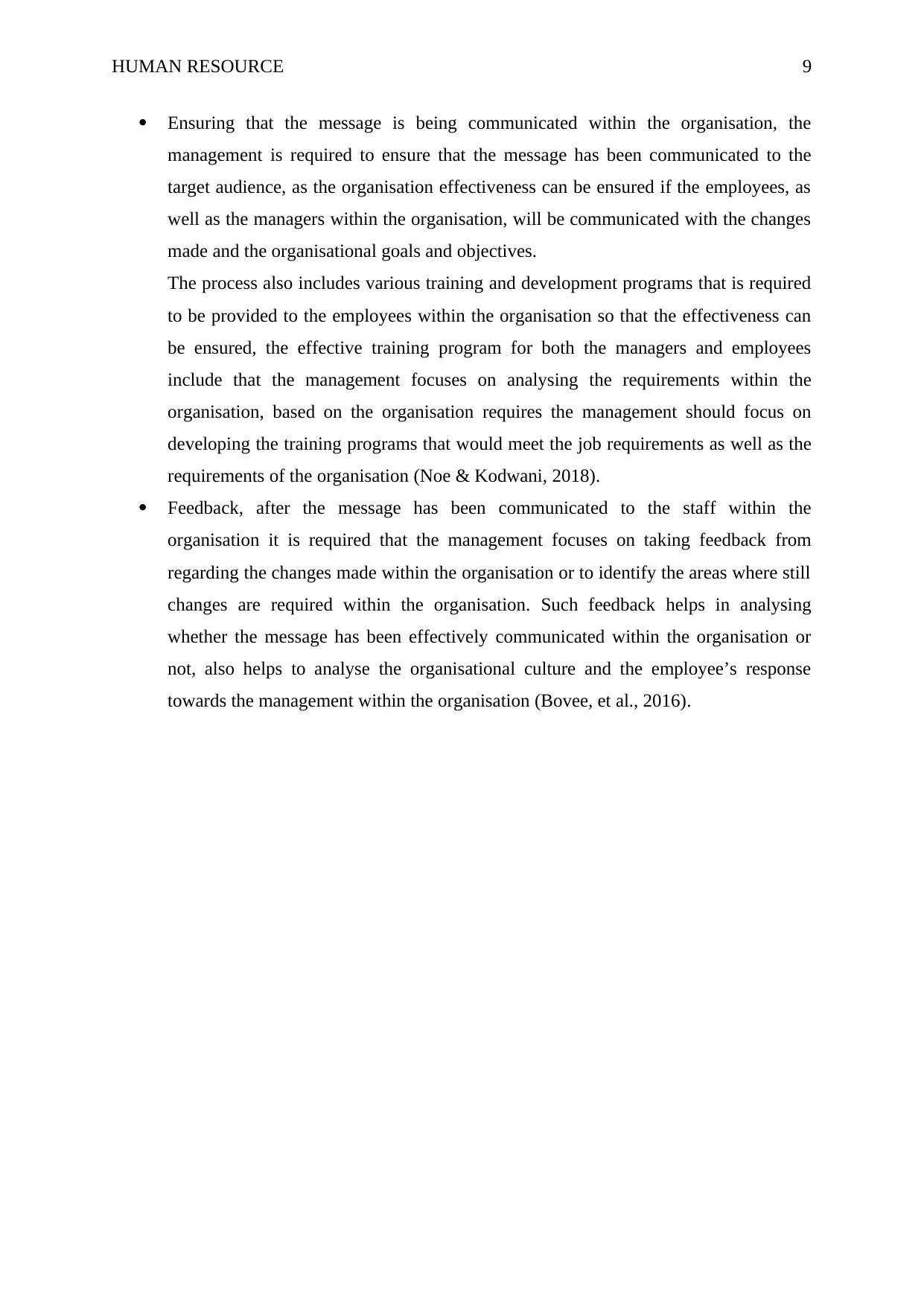
HUMAN RESOURCE 9
Ensuring that the message is being communicated within the organisation, the
management is required to ensure that the message has been communicated to the
target audience, as the organisation effectiveness can be ensured if the employees, as
well as the managers within the organisation, will be communicated with the changes
made and the organisational goals and objectives.
The process also includes various training and development programs that is required
to be provided to the employees within the organisation so that the effectiveness can
be ensured, the effective training program for both the managers and employees
include that the management focuses on analysing the requirements within the
organisation, based on the organisation requires the management should focus on
developing the training programs that would meet the job requirements as well as the
requirements of the organisation (Noe & Kodwani, 2018).
Feedback, after the message has been communicated to the staff within the
organisation it is required that the management focuses on taking feedback from
regarding the changes made within the organisation or to identify the areas where still
changes are required within the organisation. Such feedback helps in analysing
whether the message has been effectively communicated within the organisation or
not, also helps to analyse the organisational culture and the employee’s response
towards the management within the organisation (Bovee, et al., 2016).
Ensuring that the message is being communicated within the organisation, the
management is required to ensure that the message has been communicated to the
target audience, as the organisation effectiveness can be ensured if the employees, as
well as the managers within the organisation, will be communicated with the changes
made and the organisational goals and objectives.
The process also includes various training and development programs that is required
to be provided to the employees within the organisation so that the effectiveness can
be ensured, the effective training program for both the managers and employees
include that the management focuses on analysing the requirements within the
organisation, based on the organisation requires the management should focus on
developing the training programs that would meet the job requirements as well as the
requirements of the organisation (Noe & Kodwani, 2018).
Feedback, after the message has been communicated to the staff within the
organisation it is required that the management focuses on taking feedback from
regarding the changes made within the organisation or to identify the areas where still
changes are required within the organisation. Such feedback helps in analysing
whether the message has been effectively communicated within the organisation or
not, also helps to analyse the organisational culture and the employee’s response
towards the management within the organisation (Bovee, et al., 2016).
Paraphrase This Document
Need a fresh take? Get an instant paraphrase of this document with our AI Paraphraser
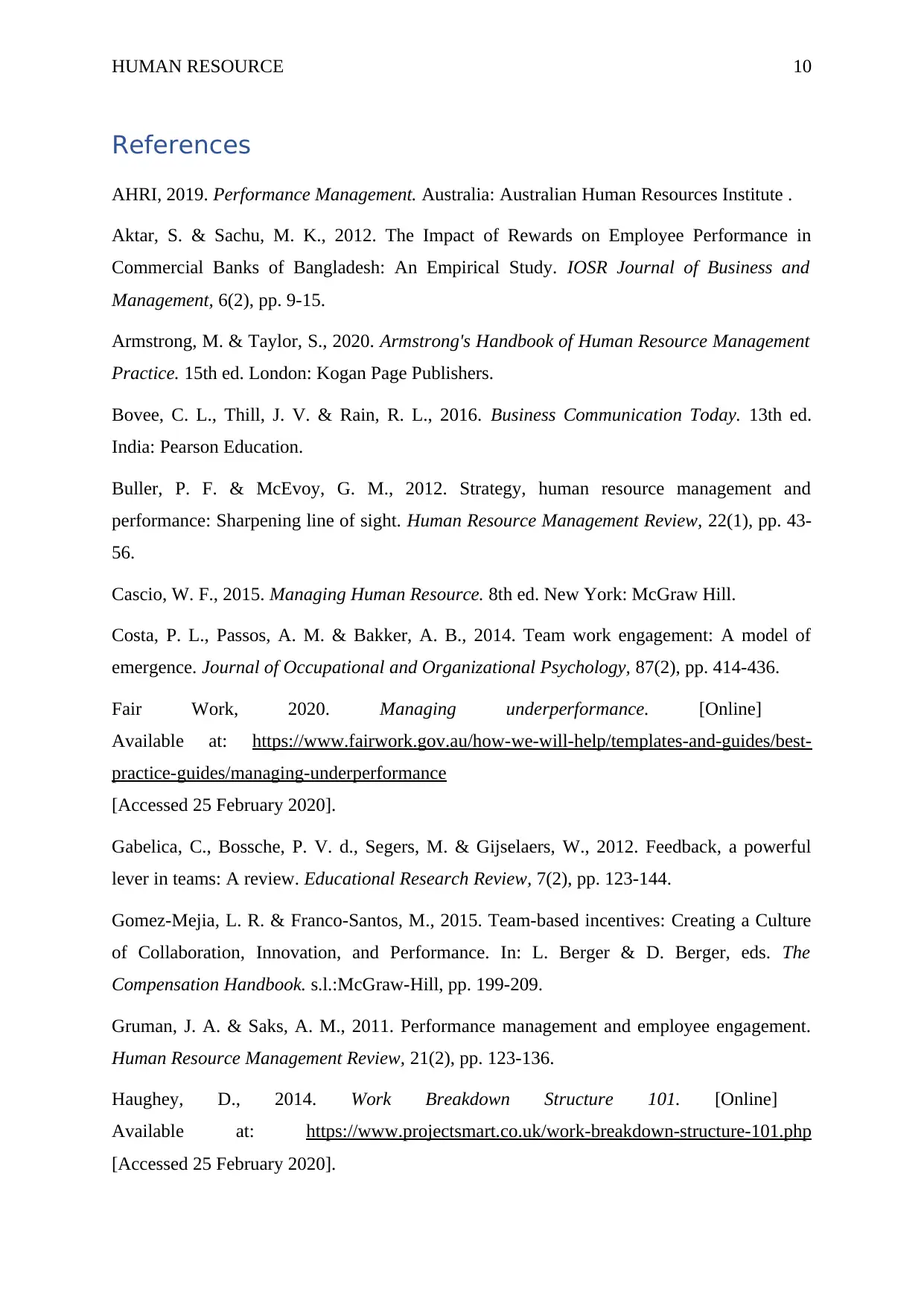
HUMAN RESOURCE 10
References
AHRI, 2019. Performance Management. Australia: Australian Human Resources Institute .
Aktar, S. & Sachu, M. K., 2012. The Impact of Rewards on Employee Performance in
Commercial Banks of Bangladesh: An Empirical Study. IOSR Journal of Business and
Management, 6(2), pp. 9-15.
Armstrong, M. & Taylor, S., 2020. Armstrong's Handbook of Human Resource Management
Practice. 15th ed. London: Kogan Page Publishers.
Bovee, C. L., Thill, J. V. & Rain, R. L., 2016. Business Communication Today. 13th ed.
India: Pearson Education.
Buller, P. F. & McEvoy, G. M., 2012. Strategy, human resource management and
performance: Sharpening line of sight. Human Resource Management Review, 22(1), pp. 43-
56.
Cascio, W. F., 2015. Managing Human Resource. 8th ed. New York: McGraw Hill.
Costa, P. L., Passos, A. M. & Bakker, A. B., 2014. Team work engagement: A model of
emergence. Journal of Occupational and Organizational Psychology, 87(2), pp. 414-436.
Fair Work, 2020. Managing underperformance. [Online]
Available at: https://www.fairwork.gov.au/how-we-will-help/templates-and-guides/best-
practice-guides/managing-underperformance
[Accessed 25 February 2020].
Gabelica, C., Bossche, P. V. d., Segers, M. & Gijselaers, W., 2012. Feedback, a powerful
lever in teams: A review. Educational Research Review, 7(2), pp. 123-144.
Gomez-Mejia, L. R. & Franco-Santos, M., 2015. Team-based incentives: Creating a Culture
of Collaboration, Innovation, and Performance. In: L. Berger & D. Berger, eds. The
Compensation Handbook. s.l.:McGraw-Hill, pp. 199-209.
Gruman, J. A. & Saks, A. M., 2011. Performance management and employee engagement.
Human Resource Management Review, 21(2), pp. 123-136.
Haughey, D., 2014. Work Breakdown Structure 101. [Online]
Available at: https://www.projectsmart.co.uk/work-breakdown-structure-101.php
[Accessed 25 February 2020].
References
AHRI, 2019. Performance Management. Australia: Australian Human Resources Institute .
Aktar, S. & Sachu, M. K., 2012. The Impact of Rewards on Employee Performance in
Commercial Banks of Bangladesh: An Empirical Study. IOSR Journal of Business and
Management, 6(2), pp. 9-15.
Armstrong, M. & Taylor, S., 2020. Armstrong's Handbook of Human Resource Management
Practice. 15th ed. London: Kogan Page Publishers.
Bovee, C. L., Thill, J. V. & Rain, R. L., 2016. Business Communication Today. 13th ed.
India: Pearson Education.
Buller, P. F. & McEvoy, G. M., 2012. Strategy, human resource management and
performance: Sharpening line of sight. Human Resource Management Review, 22(1), pp. 43-
56.
Cascio, W. F., 2015. Managing Human Resource. 8th ed. New York: McGraw Hill.
Costa, P. L., Passos, A. M. & Bakker, A. B., 2014. Team work engagement: A model of
emergence. Journal of Occupational and Organizational Psychology, 87(2), pp. 414-436.
Fair Work, 2020. Managing underperformance. [Online]
Available at: https://www.fairwork.gov.au/how-we-will-help/templates-and-guides/best-
practice-guides/managing-underperformance
[Accessed 25 February 2020].
Gabelica, C., Bossche, P. V. d., Segers, M. & Gijselaers, W., 2012. Feedback, a powerful
lever in teams: A review. Educational Research Review, 7(2), pp. 123-144.
Gomez-Mejia, L. R. & Franco-Santos, M., 2015. Team-based incentives: Creating a Culture
of Collaboration, Innovation, and Performance. In: L. Berger & D. Berger, eds. The
Compensation Handbook. s.l.:McGraw-Hill, pp. 199-209.
Gruman, J. A. & Saks, A. M., 2011. Performance management and employee engagement.
Human Resource Management Review, 21(2), pp. 123-136.
Haughey, D., 2014. Work Breakdown Structure 101. [Online]
Available at: https://www.projectsmart.co.uk/work-breakdown-structure-101.php
[Accessed 25 February 2020].
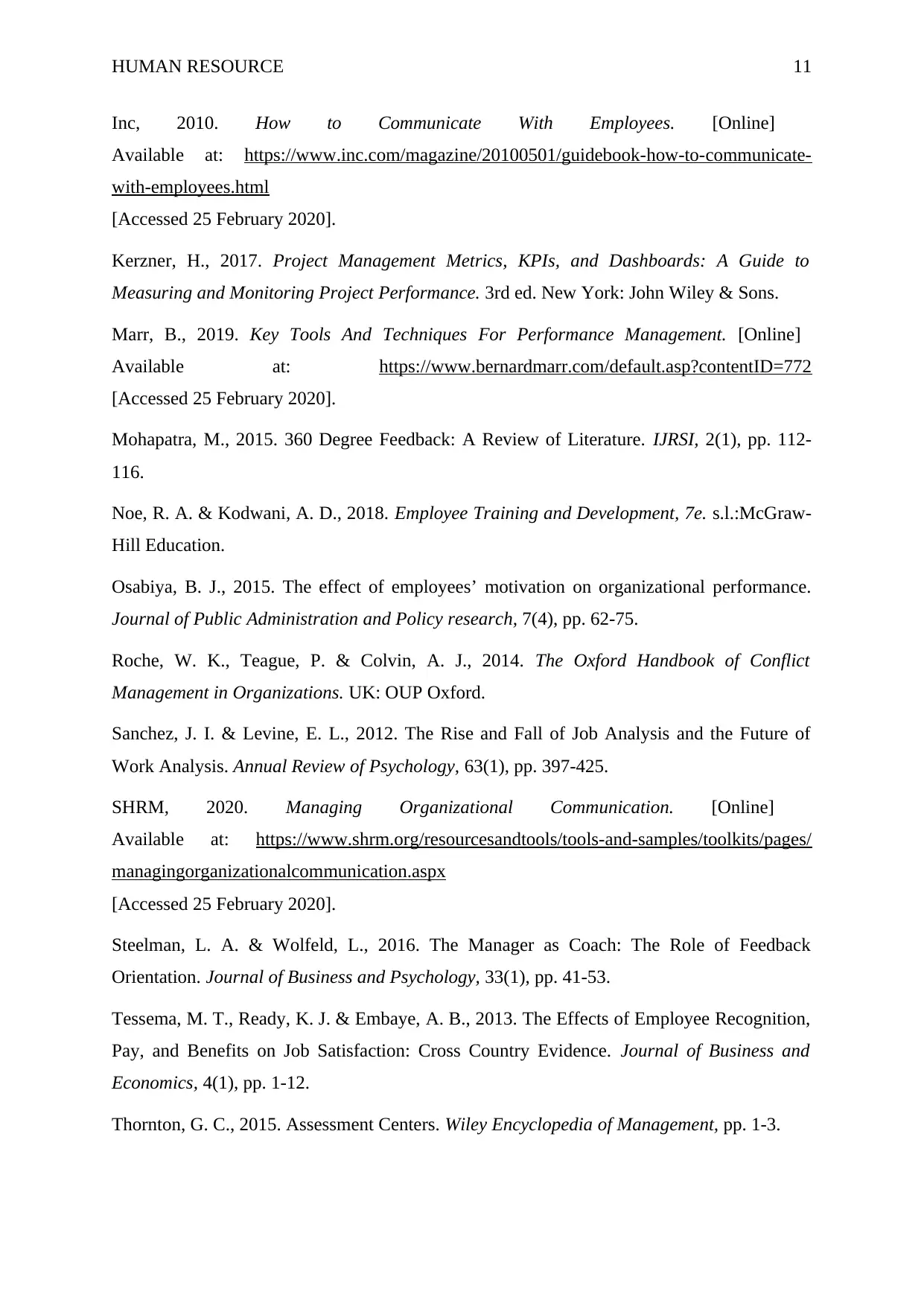
HUMAN RESOURCE 11
Inc, 2010. How to Communicate With Employees. [Online]
Available at: https://www.inc.com/magazine/20100501/guidebook-how-to-communicate-
with-employees.html
[Accessed 25 February 2020].
Kerzner, H., 2017. Project Management Metrics, KPIs, and Dashboards: A Guide to
Measuring and Monitoring Project Performance. 3rd ed. New York: John Wiley & Sons.
Marr, B., 2019. Key Tools And Techniques For Performance Management. [Online]
Available at: https://www.bernardmarr.com/default.asp?contentID=772
[Accessed 25 February 2020].
Mohapatra, M., 2015. 360 Degree Feedback: A Review of Literature. IJRSI, 2(1), pp. 112-
116.
Noe, R. A. & Kodwani, A. D., 2018. Employee Training and Development, 7e. s.l.:McGraw-
Hill Education.
Osabiya, B. J., 2015. The effect of employees’ motivation on organizational performance.
Journal of Public Administration and Policy research, 7(4), pp. 62-75.
Roche, W. K., Teague, P. & Colvin, A. J., 2014. The Oxford Handbook of Conflict
Management in Organizations. UK: OUP Oxford.
Sanchez, J. I. & Levine, E. L., 2012. The Rise and Fall of Job Analysis and the Future of
Work Analysis. Annual Review of Psychology, 63(1), pp. 397-425.
SHRM, 2020. Managing Organizational Communication. [Online]
Available at: https://www.shrm.org/resourcesandtools/tools-and-samples/toolkits/pages/
managingorganizationalcommunication.aspx
[Accessed 25 February 2020].
Steelman, L. A. & Wolfeld, L., 2016. The Manager as Coach: The Role of Feedback
Orientation. Journal of Business and Psychology, 33(1), pp. 41-53.
Tessema, M. T., Ready, K. J. & Embaye, A. B., 2013. The Effects of Employee Recognition,
Pay, and Benefits on Job Satisfaction: Cross Country Evidence. Journal of Business and
Economics, 4(1), pp. 1-12.
Thornton, G. C., 2015. Assessment Centers. Wiley Encyclopedia of Management, pp. 1-3.
Inc, 2010. How to Communicate With Employees. [Online]
Available at: https://www.inc.com/magazine/20100501/guidebook-how-to-communicate-
with-employees.html
[Accessed 25 February 2020].
Kerzner, H., 2017. Project Management Metrics, KPIs, and Dashboards: A Guide to
Measuring and Monitoring Project Performance. 3rd ed. New York: John Wiley & Sons.
Marr, B., 2019. Key Tools And Techniques For Performance Management. [Online]
Available at: https://www.bernardmarr.com/default.asp?contentID=772
[Accessed 25 February 2020].
Mohapatra, M., 2015. 360 Degree Feedback: A Review of Literature. IJRSI, 2(1), pp. 112-
116.
Noe, R. A. & Kodwani, A. D., 2018. Employee Training and Development, 7e. s.l.:McGraw-
Hill Education.
Osabiya, B. J., 2015. The effect of employees’ motivation on organizational performance.
Journal of Public Administration and Policy research, 7(4), pp. 62-75.
Roche, W. K., Teague, P. & Colvin, A. J., 2014. The Oxford Handbook of Conflict
Management in Organizations. UK: OUP Oxford.
Sanchez, J. I. & Levine, E. L., 2012. The Rise and Fall of Job Analysis and the Future of
Work Analysis. Annual Review of Psychology, 63(1), pp. 397-425.
SHRM, 2020. Managing Organizational Communication. [Online]
Available at: https://www.shrm.org/resourcesandtools/tools-and-samples/toolkits/pages/
managingorganizationalcommunication.aspx
[Accessed 25 February 2020].
Steelman, L. A. & Wolfeld, L., 2016. The Manager as Coach: The Role of Feedback
Orientation. Journal of Business and Psychology, 33(1), pp. 41-53.
Tessema, M. T., Ready, K. J. & Embaye, A. B., 2013. The Effects of Employee Recognition,
Pay, and Benefits on Job Satisfaction: Cross Country Evidence. Journal of Business and
Economics, 4(1), pp. 1-12.
Thornton, G. C., 2015. Assessment Centers. Wiley Encyclopedia of Management, pp. 1-3.
⊘ This is a preview!⊘
Do you want full access?
Subscribe today to unlock all pages.

Trusted by 1+ million students worldwide
1 out of 13
Related Documents
Your All-in-One AI-Powered Toolkit for Academic Success.
+13062052269
info@desklib.com
Available 24*7 on WhatsApp / Email
![[object Object]](/_next/static/media/star-bottom.7253800d.svg)
Unlock your academic potential
Copyright © 2020–2025 A2Z Services. All Rights Reserved. Developed and managed by ZUCOL.




